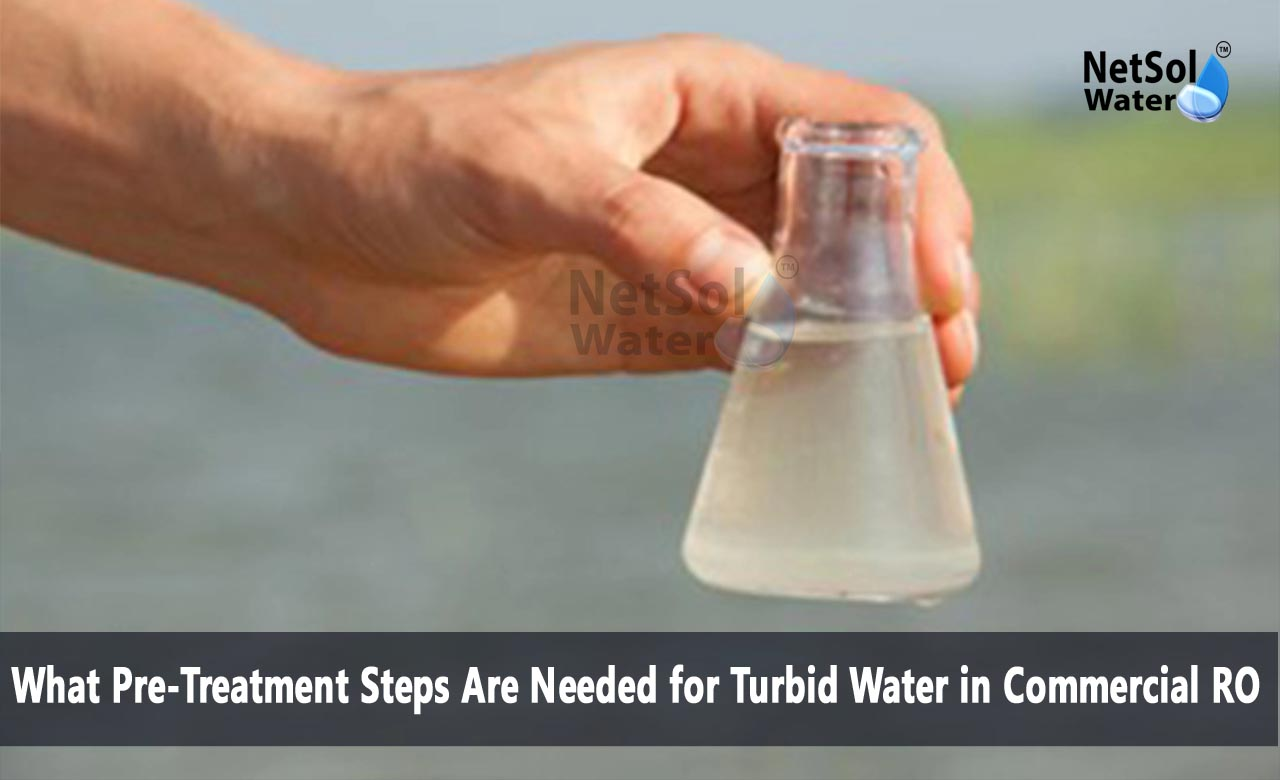What Pre-Treatment Steps Are Needed for Turbid Water in Commercial RO?
One common challenge in commercial RO plants involves the treatment of turbid water. Turbidity can harm membranes and lower system output. Netsol Water offers full support for pre treatment steps. These steps prepare turbid feed water for smooth operation. They protect the membranes from clogging and damage. They also extend service life and lower downtime. We will cover what pre treatment steps are needed for turbid water in commercial RO plants.
Screening and Sedimentation
Pre treatment steps for turbid water in commercial RO plants begin with removing large particles. This stage sets the base for further cleaning. Proper removal of debris improves the next stages. Let us have a look at some methods that work well.
Screening
Screening catches large solids in the raw water. It uses a mesh or perforated plate. Water passes through this barrier. Solids rest on the screen surface. Netsol Water systems use robust screens. They lock out sticks and leaves and gravel and trash. This step prevents damage to pumps and valves.
Sedimentation
Sedimentation lets finer particles settle under gravity. It uses a plain tank or clarifier. Water enters at low speed. Heavier particles sink to the bottom. Clear water flows out from the top. Netsol Water offers sedimentation tanks that work continuously. They remove mud clay and other fine solids.
Efficient screening and sedimentation ensure the feed water moves to the next stage with reduced load. This ratio of solids removal boosts the overall system performance.
Coagulation and Flocculation
Removing small particles demands a chemical assist. Coagulation and flocculation join fine solids into larger clusters. These clusters settle or filter more easily. Pre treatment steps for turbid water in commercial RO must include this stage. Let us have a look at some details that make it work.
Coagulation
Coagulation injects a chemical that neutralises particle charge. This shift allows tiny particles to stick together. Netsol Water selects the right coagulant dose for each feed water. Operators monitor dose and mixing intensity. They ensure full contact with the water.
Flocculation
Flocculation follows coagulation. It uses gentle stirring to grow the clusters. Slow mixing balances collision and stability. The mixer speed and time matter. Netsol Water designs flocculation tanks for even mixing. They avoid shear that might break the flocs.
When coagulation and flocculation work well they form flocs that settle fast. This stage cut down turbidity before filtration.
Media Filtration
After flocculation the water still holds flocs and fine solids. Media filtration uses layers of sand or other media to trap these solids. This step removes remaining turbidity. It offers higher quality feed water for RO. Let us have a look at some features of this stage.
Multi-Media Filters
Multi-media filters stack layers of media by density. Coarse material sits on top. Fine sand forms the bottom layer. Water flows down through each layer. Trapped solids cling to the grains. Netsol Water builds these filters with robust vessels. They handle large flows and high pressures.
Backwash Cycles
Trapped solids collect in the media bed. The filter needs periodic cleaning. Backwash reverses the flow. Air and water flush the media. This step ejects the solids. Netsol Water offers automated backwash controls. They set timing and flow rates for best cleaning.
Media filtration cuts turbidity and protects the RO membranes from abrasion.
pH Adjustment
Feed water may need pH correction before it reaches the RO membranes. This stage prevents damage to membranes from extreme pH. It also boosts system efficiency. Let us have a look at some practices that help.
Acid Dosing
If the water has high pH an acid dose can bring it down. Netsol Water chooses the right acid type and dose. It uses inline pH sensors to track the values. This feedback loop keeps the pH in the target zone.
Alkali Dosing
When the water has low pH an alkali dose can lift it to safe levels. Operators add a base like sodium hydroxide. Netsol Water installs dosing pumps and control units. They ensure stable pH during operation.
Controlled pH protects the membranes from scaling and chemical attack.
Disinfection
A final pre treatment step for turbid water in commercial RO uses disinfection. This stage kills bacteria and biological growth. It prevents biofilm on the membranes. Let us have a look at some key methods.
Chlorination
Chlorine can inactivate most microbes in the feed water. Netsol Water injects chlorine in small controlled amounts. This step requires dechlorination before the RO to avoid membrane damage.
UV Treatment
Ultraviolet light can disinfect water without chemicals. UV lamps expose the water for a short time. They break down microbial DNA. Netsol Water integrates UV chambers after filtration. They add no taste or odour. This step offers safe water for RO.
Proper disinfection keeps the system free from biofouling and extends its life.
Conclusion
Netsol Water shows clear leadership in guiding clients on what pre treatment steps are needed for turbid water in commercial RO. Each stage builds on the last to protect the membranes and deliver clean water. You can trust Netsol Water for expert design and support. Contact our team today for more information or request a consultation to see how we can help your project succeed.
Contact Netsol Water at:
Phone: +91-9650608473, Email: enquiry@netsolwater.com



